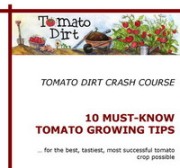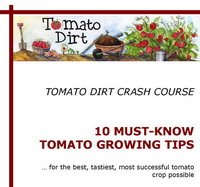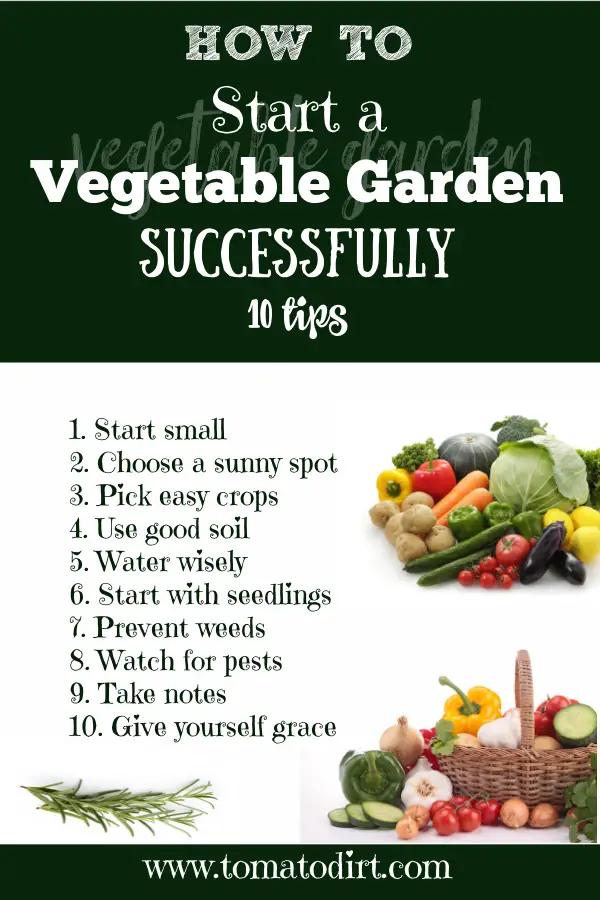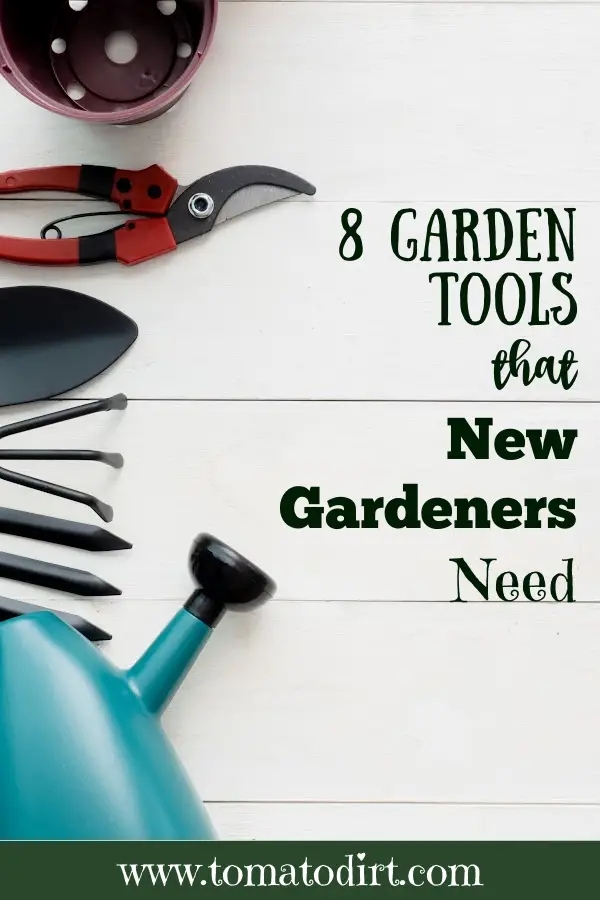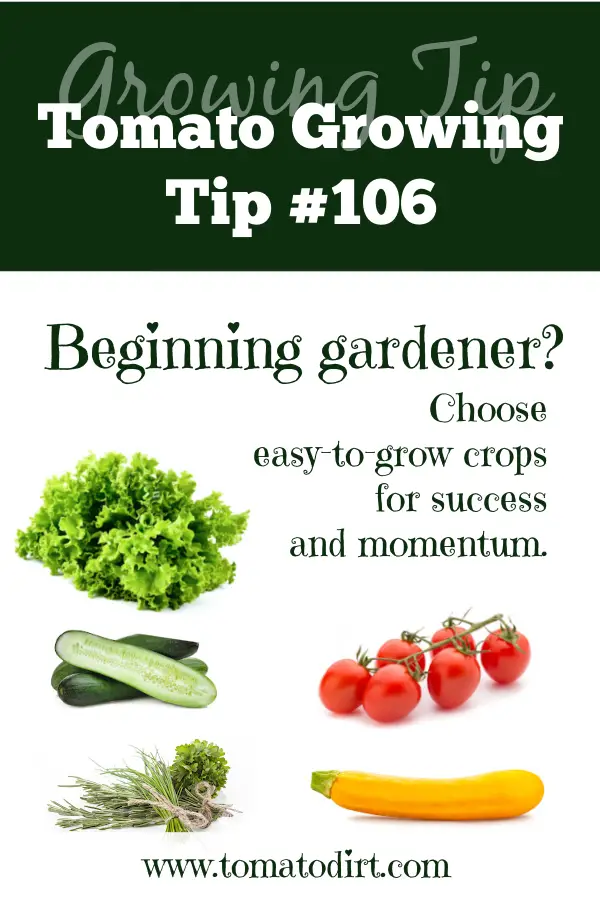FREE: 10 Must-Know Tomato Growing Tips Get The Guide
Read our affiliate disclosure here.
How To Start a Vegetable Garden Successfully: 10 Tips For Beginner Gardeners
Since 2010, Tomato Dirt has garnered 4.8+ million views, making it the web’s leading online source for growing tomatoes in the home garden. Award-winning writer and Tomato Dirt owner Kathy Widenhouse has helped thousands of home gardeners grow healthier tomatoes. Be one of them when you get Tomato Dirt’s Growing Guide here.
Posted 4.15.25
Gardening newbie … or veteran gardener who may be discouraged? Yes, you can start a vegetable garden successfully and help it thrive until frost.
It’s not unusual for beginning gardeners (and even experience gardeners, to be honest) to launch into a new season brimming with anticipation. The soil is warming. Garden centers start to fill with seedlings. Gray, cold days have passed and the sun is out…
Good news: that exhilaration can last all season long and gardening can become a lifelong passion when you set yourself up for success. Use these 10 tips to start a vegetable garden successfully so you can have a healthy harvest during your very first season.
Start a vegetable garden successfully: 10 tips
1. Start small
Begin by choosing the type of vegetable garden that's right for you -- one with a manageable space. An 8 x 8 plot, a 4x4 raised bed, or even just a few large containers is enough for a beginner. Too much space means more weeding, watering, and maintenance, which can feel overwhelming.
2. Choose a sunny spot
Veggies need at least 6 hours of sunlight per day. And while you’re at it, pick a garden location close to a water source to make watering easier.
3. Choose easy-to-grow vegetables
Pick beginner-friendly crops that are forgiving and produce
results quickly:
- Leafy greens: Lettuce, spinach, and kale grows fast and doesn’t need much care.
- Radishes: Harvest your first wave in less than a month.
- Cherry tomatoes: They are easier to grow than globe or beefsteak tomatoes – and many varieties are even more flavorful than their large-sized counterparts.
- Zucchini and cucumbers: They are fast-growing and produces a lot with little effort.
- Basil, mint and chives: These simple herbs require almost no work and thrive in most conditions.
4. Use quality soil
Soil becomes home to your vegetables. Plus, good soil means strong, healthy plants. If you start a vegetable garden in the ground, be sure to add a layer of rich compost. If you’re working in containers, fill them with a mix of compost, garden soil, and potting mix. Raised beds? Buy pre-mixed raised bed soil to skip the hassle.
5. Water wisely
Even if Mother Nature blesses you with occasional summer showers, chances are good you will need to provide extra water for your thirsty plants, particularly during a heat wave. Plan to water your novice garden.
- Deep watering 2-3 times per week is better than daily shallow watering.
- Use mulch to keep soil moist and reduce weeds.
- Water early in the morning to prevent evaporation and disease.
6. Start with seedlings, rather than seeds
- Buy starter plants from a nursery saves time, frustration, and worry over germination rates. Choose seedlings for larger plants like tomatoes, zucchini, peppers, squash, cucumbers, and melons – and herbs like oregano, dill, basil, and chives.
- Plant seeds for direct sow crops that are also quick growers like radishes, lettuce, and green beans.
7. Prevent weeds from Day 1
Weeds choke your plants and create all kinds of extra work
your you, dear gardener. Full disclosure: you will need to weed, no matter how clean your soil is. But
plan ahead before these little gremlins arrive and take some steps to keep them
at bay.
- Don’t till too deep when preparing your garden—this brings weed seeds to the surface.
- If you start a vegetable garden in a new area, smother weeds with cardboard before planting.
- Once you’ve planted, lay down mulch around your plants (straw, wood chips, shredded leaves, or black plastic) to stop weeds.
- Use a hoe to cultivate in between rows during growing season. You’ll uproot weed seedlings before they get strong,
8. Watch for pests and diseases early
- Tomato worms, aphids, whiteflies … they know a good thing when it moves into their neighborhood. Show them they are not welcome by catching them before they spread.
- Inspect plants daily for holes, yellowing, or bugs. Hand-pick pests or use natural solutions like neem oil.
- Ditto for fungi, wilt, and other diseases. The key, as it is for humans, is early detection so you can launch a counterassault.
9. Keep notes for next year
Write down what works (and what doesn’t) in a simple notebook or garden journal. Track when you planted, what you grew, and any challenges you faced. This will make next year’s garden even better!
10. Top tip: grow gardener’s grace
Not every plant will thrive, and that’s okay! Gardening takes learning—don’t be discouraged by setbacks. Instead, celebrate your small wins, like your first ripe tomato! Most of all, have fun.
Start a vegetable garden successfully with 8 tools or less
As a beginner, you don’t need a ton of fancy tools—just the essentials to make gardening easier and more enjoyable. Here’s the dirt on must-have tools to get started gardening. ( I’ve also included a short list of nice-to-have extras that will come in handy later.)
1. Hand trowel
- Why you need it: If you get just one gardening tool, this is it. Your hand trowel is essential for digging, planting, and moving soil.
- Tips: Look for a stainless steel blade with a comfortable grip. A trowel with measurement markings helps with seed depth.
2. Hand pruners (also called bypass shears)
- Why you need them: When you’re staring at a plot of unturned earth, it’s hard to imagine that in a few short months you’ll trim plants, cut herbs, and harvest veggies. The fact is that your office scissors or even your kitchen shears just won’t do the job. You need pruners unless you plan to sacrifice your fingernails to the gardening gods.
- Tips: Choose bypass pruners, which make clean cuts (better for plants). Keep your pruners sharp to avoid damaging plants.
3. Garden gloves
- Why you need them: Protect your hands from thorns, dirt, and blisters so you can keep gardening all season long.
- Tips: Choose breathable, water-resistant gloves for comfort. Get a snug fit—loose gloves make gripping tools harder.
4. Garden hoe or hand cultivator
- Why you need it: A hoe loosens soil, whether it’s breaking clods of freshly turned soil in the spring or turning up weeds in between rows in the mid-season.
- Tips: A long-handled hoe is best for larger gardens. A hand cultivator (small rake-like tool) is great for raised beds. Stirrup hoes (oscillating hoes) are excellent for quick weeding.
5. Watering hose or watering can
- Why you need it: Plants need water – and Mother Nature doesn’t provide enough with sprinkles or even rainstorms.
- Tips: If you garden in containers or a raised bed, choose a watering can with a removable spout for gentle watering. A hose with an adjustable spray nozzle is ideal for bigger gardens. Water early in the morning to reduce evaporation and disease.
6. Garden rake (optional for raised beds, essential for ground gardens)
- Why you need it: A rake breaks up soil, levels beds, and removes debris.
- Tips: A lightweight metal rake works best.If you have a small raised bed, you can skip the rake and use a hand cultivator instead.
7. Mulching material
- Why you need it: Mulch keeps down weeds, prevents evaporation, and amends the soil.
- Tips: Try different types of mulch (straw, wood chips, or shredded leaves) to find out what’s easiest, cheapest, and best for your garden.
8. Garden journal
- Why you need it: What varieties did you plant? Where? When did your plants germinate, start flowering, begin fruiting, bear their first harvest? How often did you water? What did you use for fertilizer? Unless you want to fill your head with all those details, write them down. Keeping a garden journal will help track what works so next year you can get a running start.
- Tip: You can use a dedicated garden journal or even a simple notebook to record details. The point is to take notes in one place so next season is even better than this one.
Nice-to-have garden tools you’ll enjoy when you start a vegetable garden
Here are a few tools that make your gardening experience more fruitful. They’re optional, particularly when you’re starting out. Add them to your collection as you can afford them … look for them on discount at local thrift and online sales … or as for them as gifts.
- A kneeling pad: Save your knees and keep your clothing from getting filthy while you work in the garden.
- Wheelbarrow or garden cart: Use it to haul compost, mulch, and debris to and from your gardening area.
- Compost bin: Every garden needs black gold to improve the soil. Whether your compost bin is stationery or portable, you can use it to turn kitchen scraps, grass clippings, and leaves into free fertilizer.
- Row covers: Protect your plants from pests and frost.
- Soil test kit: Find out what nutrients your soil needs so you can amend it and make it a more fruitful home for your vegetables.
Bonus hacks to try when you start a vegetable garden
- Use self-watering containers to cut down on watering.
- Grow vertically (trellis tomatoes, cucumbers, beans) to save space and effort.
- Skip digging. Lay down cardboard or black plastic to eliminate (or at least drastically reduce) weeds. Punch holes to plant seedlings or seeds.
- Use a garden starter kit to jumpstart your choices and reduce overwhelm.
Start a vegetable garden successfully – and thrive
Gardening can feel overwhelming at first. Keep yours small. Choose easy plants. Don’t run out and buy every tool right away.
Instead, start with the basics and have fun. As you start to enjoy victories, then add more space, more varieties, and more tools next season.
More on Starting a Vegetable Garden
What Type of Vegetable Garden Is Best for You?
How to plan a garden layout for growing vegetables and tomatoes ...
3 Ways to Prepare Your Garden for Spring ...
3 types of planting in rows for your vegetable garden ...
Preparing Soil for Tomatoes: Frequently Asked Questions ...
Tips for Planning a Vegetable Garden, Even In The Winter …
7 Very Cheap Garden Fence Ideas ...
More tips for Beginning Gardeners on our Pinterest board ...
Return from How To Start a Vegetable Garden Tips to Tomato Dirt home
As an Amazon Associate and Rakuten Advertising affiliate I earn from qualifying purchases.
SHARE THIS PAGE:
FREE! 10 Must-Know Tomato Growing Tips: 20-page guide
Get yours here:
